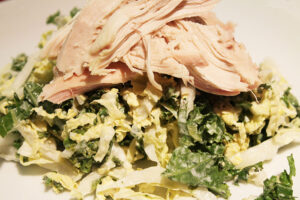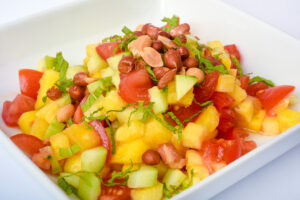Eating the Med Way
go.ncsu.edu/readext?1029165
en Español / em Português
El inglés es el idioma de control de esta página. En la medida en que haya algún conflicto entre la traducción al inglés y la traducción, el inglés prevalece.
Al hacer clic en el enlace de traducción se activa un servicio de traducción gratuito para convertir la página al español. Al igual que con cualquier traducción por Internet, la conversión no es sensible al contexto y puede que no traduzca el texto en su significado original. NC State Extension no garantiza la exactitud del texto traducido. Por favor, tenga en cuenta que algunas aplicaciones y/o servicios pueden no funcionar como se espera cuando se traducen.
Português
Inglês é o idioma de controle desta página. Na medida que haja algum conflito entre o texto original em Inglês e a tradução, o Inglês prevalece.
Ao clicar no link de tradução, um serviço gratuito de tradução será ativado para converter a página para o Português. Como em qualquer tradução pela internet, a conversão não é sensivel ao contexto e pode não ocorrer a tradução para o significado orginal. O serviço de Extensão da Carolina do Norte (NC State Extension) não garante a exatidão do texto traduzido. Por favor, observe que algumas funções ou serviços podem não funcionar como esperado após a tradução.
English
English is the controlling language of this page. To the extent there is any conflict between the English text and the translation, English controls.
Clicking on the translation link activates a free translation service to convert the page to Spanish. As with any Internet translation, the conversion is not context-sensitive and may not translate the text to its original meaning. NC State Extension does not guarantee the accuracy of the translated text. Please note that some applications and/or services may not function as expected when translated.
Collapse ▲Your doctor may have recommended the Mediterranean diet or you may have heard people talk about it. The Mediterranean lifestyle has been studied because people in this region living the traditional Mediterranean pattern not only have a longer lifespan but are able to live independently in their 80’s, 90’s and even over 100 in good health!
What Does The Med Way Mean? Going the Med Way means living the Mediterranean lifestyle. Their eating pattern incorporates the basics of healthy eating that were traditionally practiced in countries that border the Mediterranean Sea. It looks at how we can prevent and control chronic diseases and promote overall health by eating the Med Way instead of focusing on medication to address these issues.
Why Should You Go Med? Research has shown that there is a connection between lifestyle and chronic disease. The goal of this program is to help people start eating and moving in a way that can help prevent chronic disease. The statistic that ⅔ of chronic diseases, such as diabetes and heart disease, can be prevented by lifestyle changes, specifically diet and exercise. However, some medical conditions may require pharmaceutical intervention in addition to a healthy eating pattern.
In the next few weeks our food column will focus on: Changing Your Protein, Swap Your Fats and Snack On Nuts and Seeds, Eat More Fruits and Vegetables, Make Your Grains Whole, and Rethink Your Sweets.
Napa cabbage is a great variety to use in cooked and raw dishes. The combination of kale and Napa cabbage is colorful and delicious. This slaw is great as a bed for grilled chicken or grilled salmon. If you use grilled chicken, toss the chicken in lemon zest and some taco seasoning before grilling.
Here is the link to the video of this recipe.
Kale and Napa Cabbage Slaw with Chicken or Salmon
Serves 4

Kale and Napa Cabbage Slaw with Chicken or Salmon
- 2 cups finely shredded kale
- 2 cups finely shredded Napa cabbage
- 4 pieces of grilled chicken or salmon
- Dressing:
- ½ cup plain, fat-free Greek yogurt
- ¼ cup mayonnaise (olive oil mayo is a good type to use) OR 2 tablespoons olive oil
- 1 teaspoon lime zest
- 2 tablespoons lime juice (more if you like)
- 1 tablespoon Dijon mustard
Directions:
1. Whisk together all dressing ingredients in a large bowl.
2. Add the kale and cabbage and toss to combine.
3. Top with grilled chicken or salmon.
Nutritional facts per 1 cup of salad alone: Calories: 139 calories, Carbohydrates: 6 grams, Fiber: 1 gram, Protein: 5 grams, Fat: 11 grams, and Sodium: 161 mg.
Kachumber Salad with Peanuts
Serves 8

Kachumber Salad with Peanuts
- 2 large tomatoes, chopped
- 1 large English cucumber, chopped
- 1 jalapeno pepper, minced
- 1 mango, diced
- 1 cup diced pineapple
- ¼ cup chopped mint leaves
- 1 teaspoon ground cumin
- 1 teaspoon salt
- ½ teaspoon cayenne pepper
- Juice of 1 lime (approximately 1½ tablespoons)
- ½ cup Spanish peanuts
Directions:
- Toss all ingredients together except the peanuts.
- Chill, and top with peanuts when ready to serve.
Nutritional facts per ¾ cup serving: Calories: 94 calories, Carbohydrates: 12 grams, Fiber: 2 grams, Protein: 3 grams, Fat: 5 grams, and Sodium: 295 mg.
Sources for this article NC Extension Food and Nutrition, Meds instead of Meds educational program. The research and selection of tested recipes was compiled by Alyssa Letchworth, ECU student intern. For more information about the Foods and Nutrition please contact Louise L. Hinsley, Extension Agent, Family Consumer Science at the Beaufort County Center of N.C. Cooperative Extension, 155 Airport Road, Washington, 252-946-0111.



